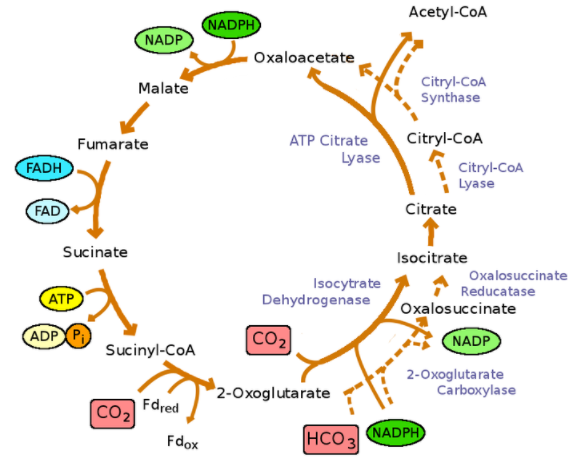
Answer
447k+ views
Hint: Krebs cycle was discovered by H.A Kreb who is a German-born British biochemist. It is the process of oxidation of glucose, fatty acid, and amino acids to produce energy. This cycle occurs in all aerobic organisms and it takes place in the matrix of mitochondria.
Complete answer:
Krebs cycle is an eight step cycle that occurs in the matrix of mitochondria. This cycle is an important metabolic pathway that connects carbohydrate, fat, and protein metabolism. It is a series of chemical reactions where energy is in the form of ATP (Adenosine triphosphate) which is produced by the oxidation of acetyl-CoA which is obtained from carbohydrates, fats, and protein. This is the reason the Krebs cycle is also known as metabolic sinks as it is a common pathway for fats, proteins, and carbohydrates which acts as a respiratory substrate and releases energy.
In this cycle redox, dehydration, and decarboxylation reactions take place. It utilizes two and four-carbon molecules to produce a six-carbon molecule which further produces carbon dioxide, ATP, and NADH (Nicotinamide dinucleotide), and FADH2 (Flavin adenine dinucleotide).
The name of this cycle is also known as citric acid because it is the first product generated by the sequence of conversions which is consumed and regenerated in the series of reactions to complete this cycle. It is also called the TCA tricarboxylic acid pathway as it contains a carboxyl group (COOH). This cycle plays a key role in the catabolism, or breakdown of organic fuel molecules such as glucose, fatty acids, and some amino acids.

Note: In the case of a prokaryotic cell, the Kreb cycle or TCA cycle occurs in the cytosol because mitochondria are absent in prokaryotic cells. NADH and FADH2 released in the TCA cycle are used up in the oxidative phosphorylation.
Complete answer:
Krebs cycle is an eight step cycle that occurs in the matrix of mitochondria. This cycle is an important metabolic pathway that connects carbohydrate, fat, and protein metabolism. It is a series of chemical reactions where energy is in the form of ATP (Adenosine triphosphate) which is produced by the oxidation of acetyl-CoA which is obtained from carbohydrates, fats, and protein. This is the reason the Krebs cycle is also known as metabolic sinks as it is a common pathway for fats, proteins, and carbohydrates which acts as a respiratory substrate and releases energy.
In this cycle redox, dehydration, and decarboxylation reactions take place. It utilizes two and four-carbon molecules to produce a six-carbon molecule which further produces carbon dioxide, ATP, and NADH (Nicotinamide dinucleotide), and FADH2 (Flavin adenine dinucleotide).
The name of this cycle is also known as citric acid because it is the first product generated by the sequence of conversions which is consumed and regenerated in the series of reactions to complete this cycle. It is also called the TCA tricarboxylic acid pathway as it contains a carboxyl group (COOH). This cycle plays a key role in the catabolism, or breakdown of organic fuel molecules such as glucose, fatty acids, and some amino acids.

Note: In the case of a prokaryotic cell, the Kreb cycle or TCA cycle occurs in the cytosol because mitochondria are absent in prokaryotic cells. NADH and FADH2 released in the TCA cycle are used up in the oxidative phosphorylation.
Recently Updated Pages
Master Class 9 Science: Engaging Questions & Answers for Success

Master Class 9 English: Engaging Questions & Answers for Success

Class 9 Question and Answer - Your Ultimate Solutions Guide

Master Class 9 Maths: Engaging Questions & Answers for Success

Master Class 9 General Knowledge: Engaging Questions & Answers for Success

Class 10 Question and Answer - Your Ultimate Solutions Guide

Trending doubts
Pigmented layer in the eye is called as a Cornea b class 11 biology CBSE

The lightest gas is A nitrogen B helium C oxygen D class 11 chemistry CBSE

Define cubit handspan armlength and footspan class 11 physics CBSE

Maximum speed of a particle in simple harmonic motion class 11 physics CBSE

Give a brief account on the canal system in sponge class 11 biology CBSE

Assertion Pila has dual mode of respiration Reason class 11 biology CBSE




